tire size Ram 5500 Chassis Cab 2012 User Guide
[x] Cancel search | Manufacturer: RAM, Model Year: 2012, Model line: 5500 Chassis Cab, Model: Ram 5500 Chassis Cab 2012Pages: 508, PDF Size: 7.01 MB
Page 334 of 508
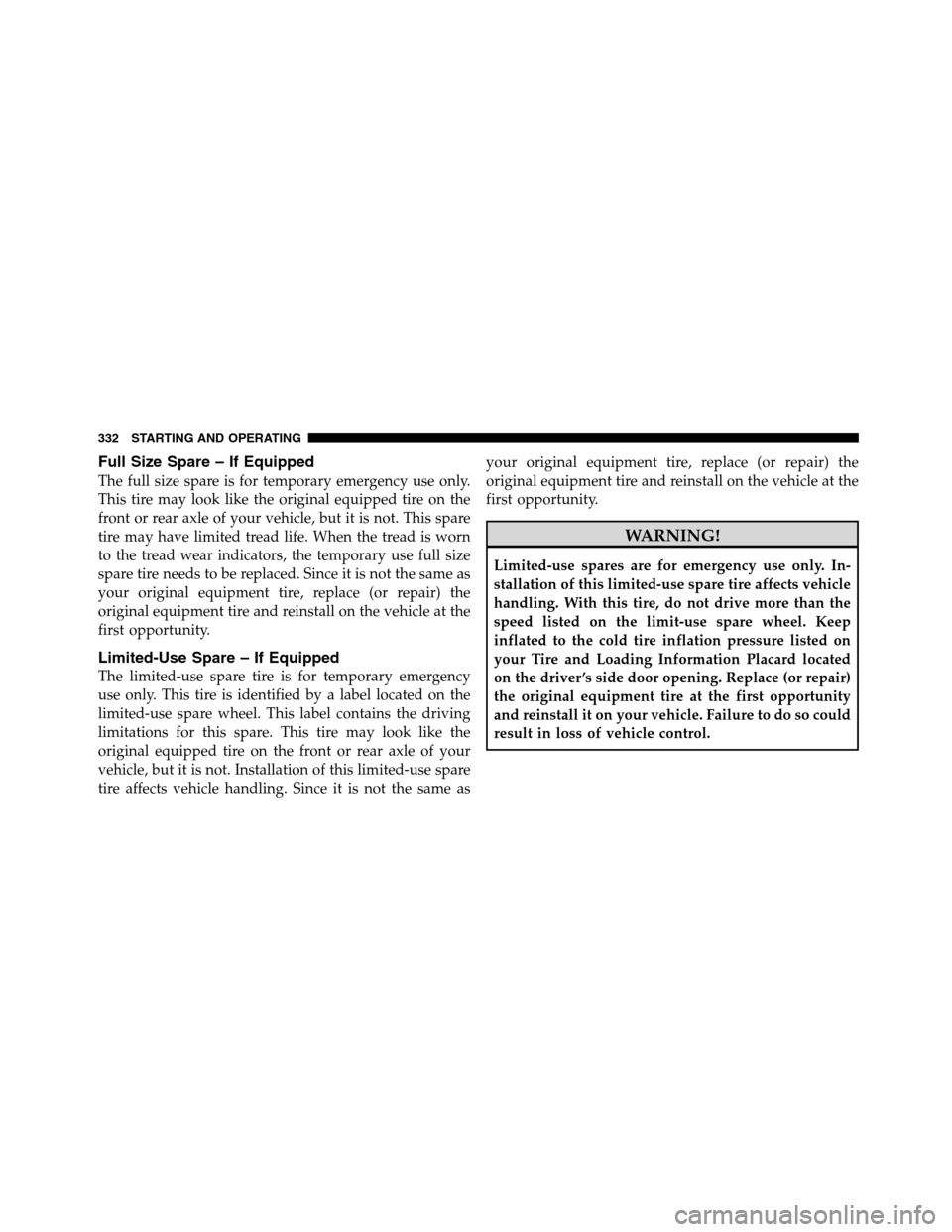
Full Size Spare ‚Äď If Equipped
The full size spare is for temporary emergency use only.
This tire may look like the original equipped tire on the
front or rear axle of your vehicle, but it is not. This spare
tire may have limited tread life. When the tread is worn
to the tread wear indicators, the temporary use full size
spare tire needs to be replaced. Since it is not the same as
your original equipment tire, replace (or repair) the
original equipment tire and reinstall on the vehicle at the
first opportunity.
Limited-Use Spare ‚Äď If Equipped
The limited-use spare tire is for temporary emergency
use only. This tire is identified by a label located on the
limited-use spare wheel. This label contains the driving
limitations for this spare. This tire may look like the
original equipped tire on the front or rear axle of your
vehicle, but it is not. Installation of this limited-use spare
tire affects vehicle handling. Since it is not the same asyour original equipment tire, replace (or repair) the
original equipment tire and reinstall on the vehicle at the
first opportunity.
WARNING!
Limited-use spares are for emergency use only. In-
stallation of this limited-use spare tire affects vehicle
handling. With this tire, do not drive more than the
speed listed on the limit-use spare wheel. Keep
inflated to the cold tire inflation pressure listed on
your Tire and Loading Information Placard located
on the driver ’s side door opening. Replace (or repair)
the original equipment tire at the first opportunity
and reinstall it on your vehicle. Failure to do so could
result in loss of vehicle control.
332 STARTING AND OPERATING
Page 336 of 508
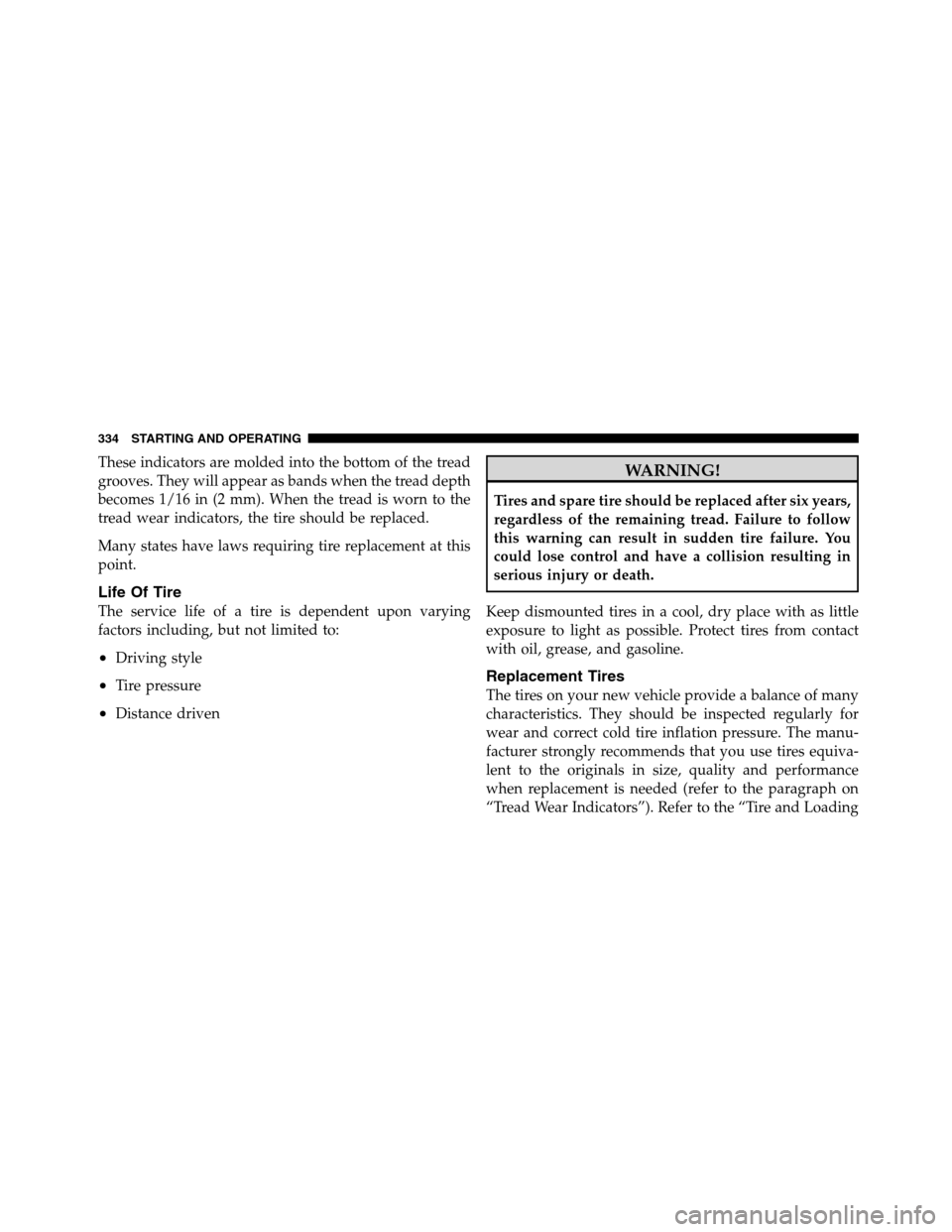
These indicators are molded into the bottom of the tread
grooves. They will appear as bands when the tread depth
becomes 1/16 in (2 mm). When the tread is worn to the
tread wear indicators, the tire should be replaced.
Many states have laws requiring tire replacement at this
point.
Life Of Tire
The service life of a tire is dependent upon varying
factors including, but not limited to:
‚ÄĘDriving style
‚ÄĘTire pressure
‚ÄĘDistance driven
WARNING!
Tires and spare tire should be replaced after six years,
regardless of the remaining tread. Failure to follow
this warning can result in sudden tire failure. You
could lose control and have a collision resulting in
serious injury or death.
Keep dismounted tires in a cool, dry place with as little
exposure to light as possible. Protect tires from contact
with oil, grease, and gasoline.
Replacement Tires
The tires on your new vehicle provide a balance of many
characteristics. They should be inspected regularly for
wear and correct cold tire inflation pressure. The manu-
facturer strongly recommends that you use tires equiva-
lent to the originals in size, quality and performance
when replacement is needed (refer to the paragraph on
‚ÄúTread Wear Indicators‚ÄĚ). Refer to the ‚ÄúTire and Loading
334 STARTING AND OPERATING
Page 337 of 508
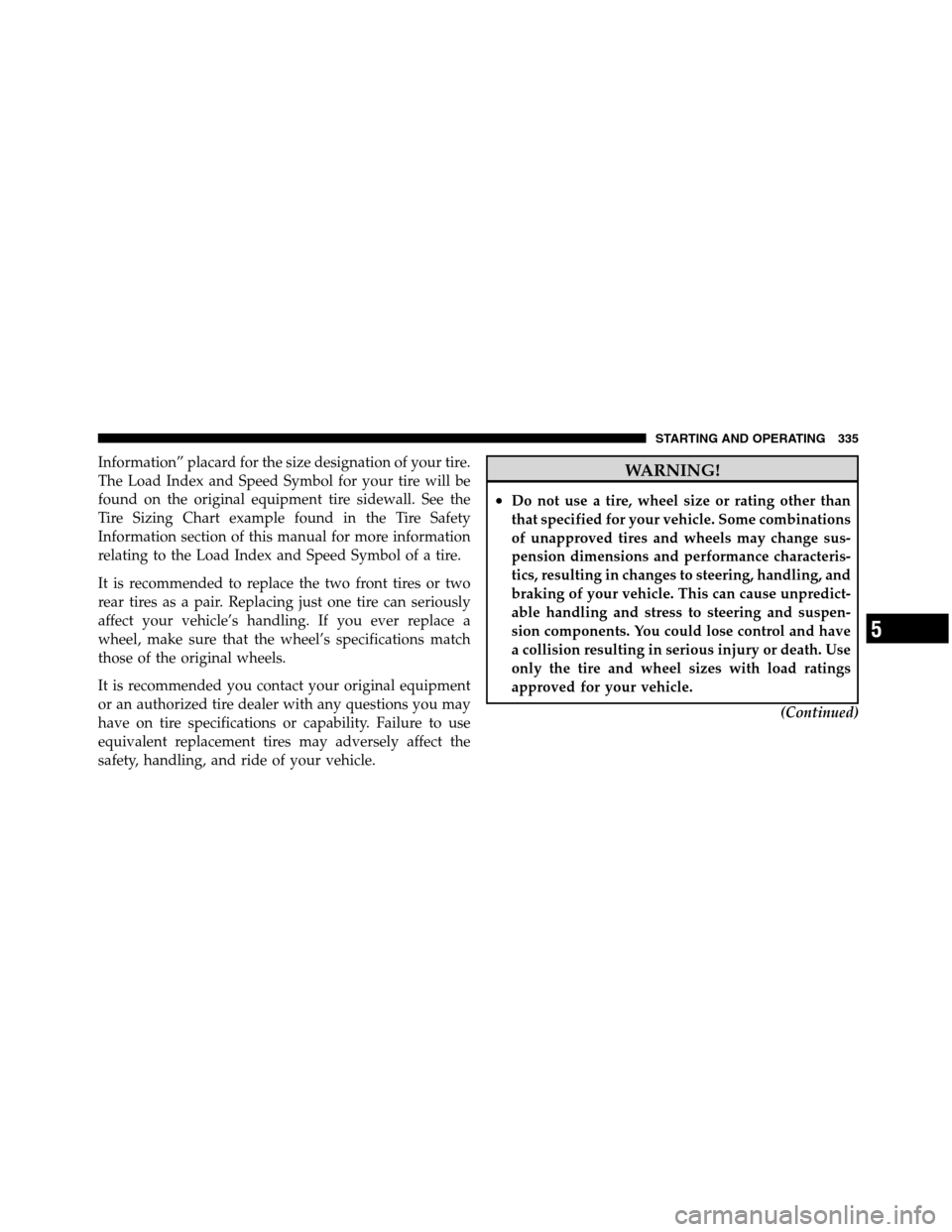
Information‚ÄĚ placard for the size designation of your tire.
The Load Index and Speed Symbol for your tire will be
found on the original equipment tire sidewall. See the
Tire Sizing Chart example found in the Tire Safety
Information section of this manual for more information
relating to the Load Index and Speed Symbol of a tire.
It is recommended to replace the two front tires or two
rear tires as a pair. Replacing just one tire can seriously
affect your vehicle’s handling. If you ever replace a
wheel, make sure that the wheel’s specifications match
those of the original wheels.
It is recommended you contact your original equipment
or an authorized tire dealer with any questions you may
have on tire specifications or capability. Failure to use
equivalent replacement tires may adversely affect the
safety, handling, and ride of your vehicle.WARNING!
‚ÄĘDo not use a tire, wheel size or rating other than
that specified for your vehicle. Some combinations
of unapproved tires and wheels may change sus-
pension dimensions and performance characteris-
tics, resulting in changes to steering, handling, and
braking of your vehicle. This can cause unpredict-
able handling and stress to steering and suspen-
sion components. You could lose control and have
a collision resulting in serious injury or death. Use
only the tire and wheel sizes with load ratings
approved for your vehicle.
(Continued)
5
STARTING AND OPERATING 335
Page 338 of 508
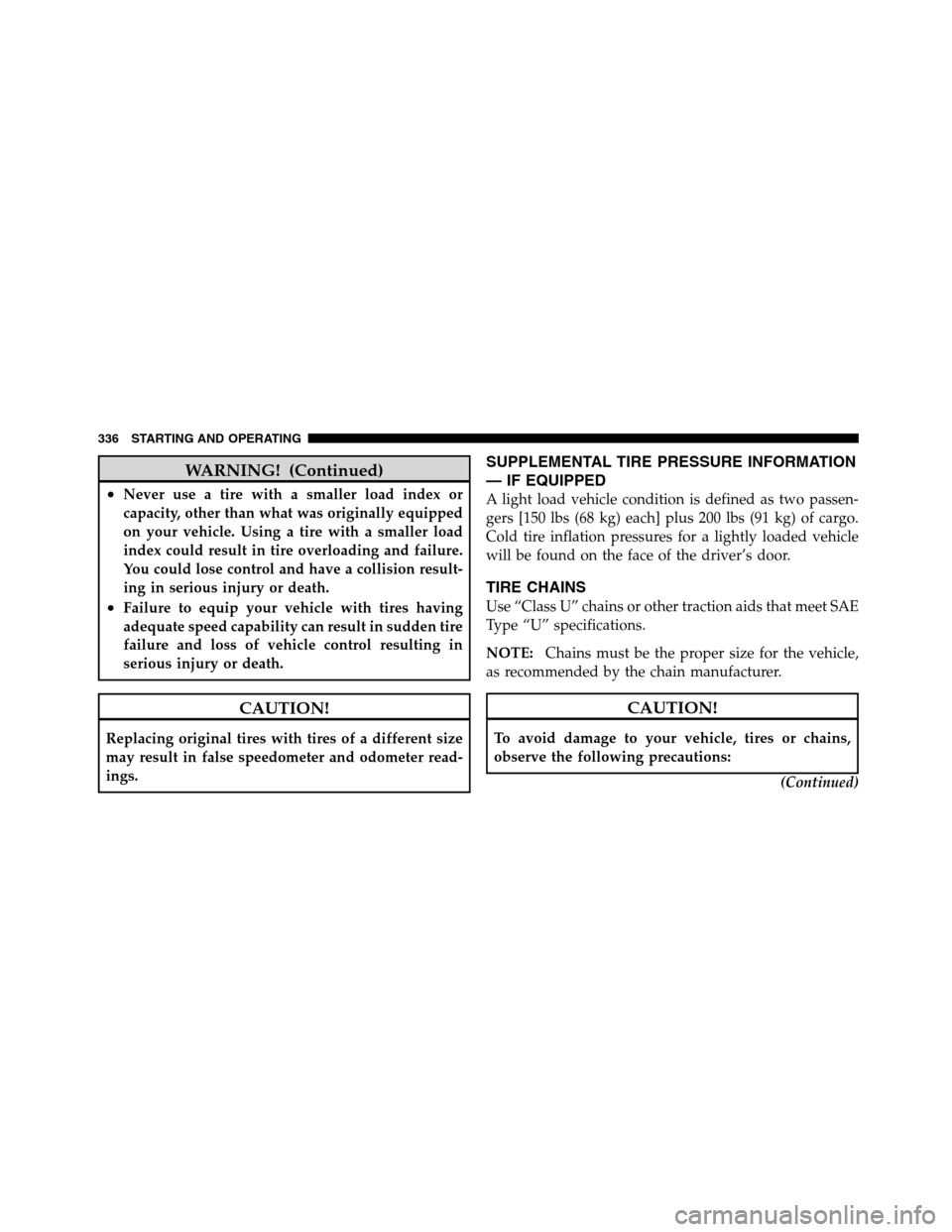
WARNING! (Continued)
‚ÄĘNever use a tire with a smaller load index or
capacity, other than what was originally equipped
on your vehicle. Using a tire with a smaller load
index could result in tire overloading and failure.
You could lose control and have a collision result-
ing in serious injury or death.
‚ÄĘFailure to equip your vehicle with tires having
adequate speed capability can result in sudden tire
failure and loss of vehicle control resulting in
serious injury or death.
CAUTION!
Replacing original tires with tires of a different size
may result in false speedometer and odometer read-
ings.
SUPPLEMENTAL TIRE PRESSURE INFORMATION
‚ÄĒ IF EQUIPPED
A light load vehicle condition is defined as two passen-
gers [150 lbs (68 kg) each] plus 200 lbs (91 kg) of cargo.
Cold tire inflation pressures for a lightly loaded vehicle
will be found on the face of the driver’s door.
TIRE CHAINS
Use ‚ÄúClass U‚ÄĚ chains or other traction aids that meet SAE
Type ‚ÄúU‚ÄĚ specifications.
NOTE:Chains must be the proper size for the vehicle,
as recommended by the chain manufacturer.
CAUTION!
To avoid damage to your vehicle, tires or chains,
observe the following precautions:
(Continued)
336 STARTING AND OPERATING
Page 340 of 508
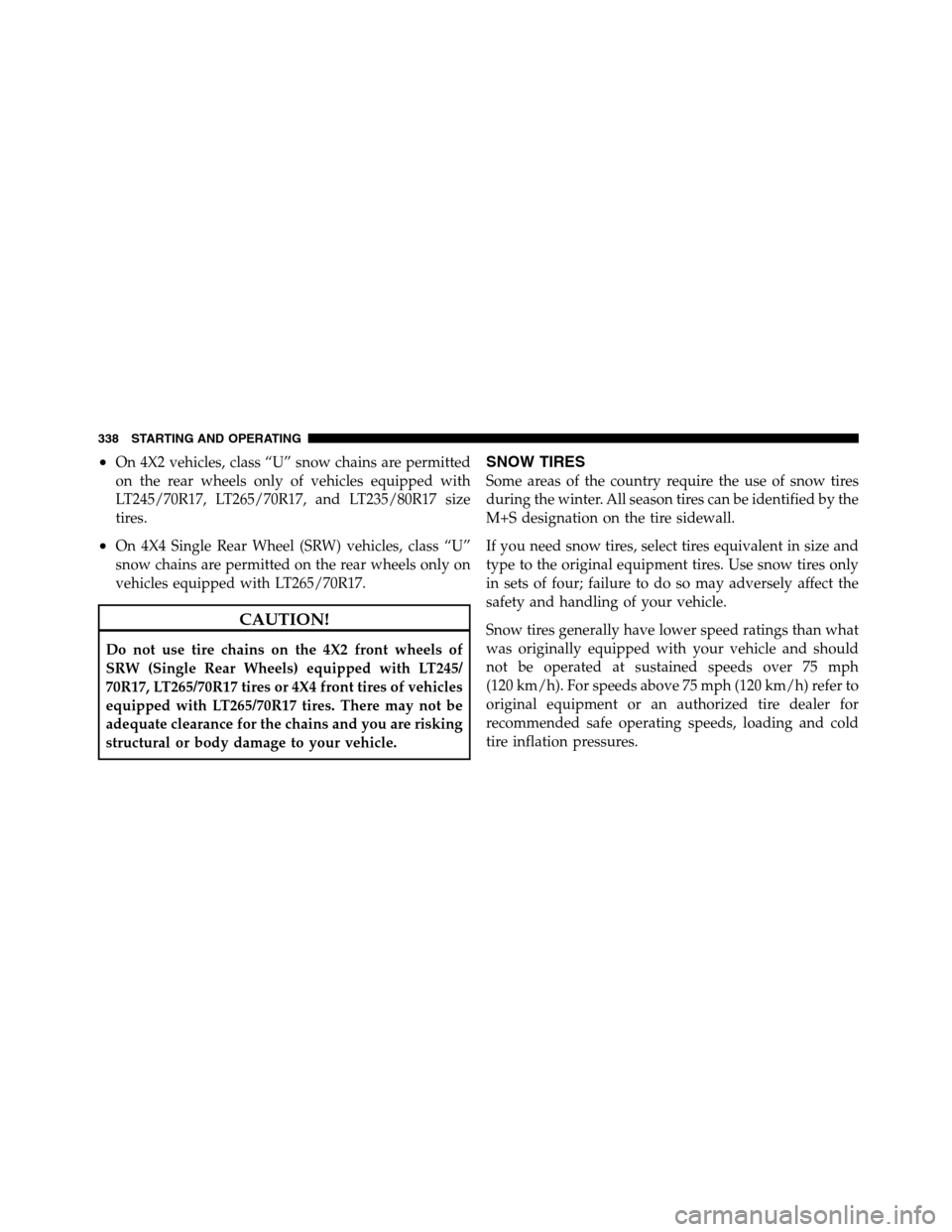
‚ÄĘOn 4X2 vehicles, class ‚ÄúU‚ÄĚ snow chains are permitted
on the rear wheels only of vehicles equipped with
LT245/70R17, LT265/70R17, and LT235/80R17 size
tires.
‚ÄĘOn 4X4 Single Rear Wheel (SRW) vehicles, class ‚ÄúU‚ÄĚ
snow chains are permitted on the rear wheels only on
vehicles equipped with LT265/70R17.
CAUTION!
Do not use tire chains on the 4X2 front wheels of
SRW (Single Rear Wheels) equipped with LT245/
70R17, LT265/70R17 tires or 4X4 front tires of vehicles
equipped with LT265/70R17 tires. There may not be
adequate clearance for the chains and you are risking
structural or body damage to your vehicle.
SNOW TIRES
Some areas of the country require the use of snow tires
during the winter. All season tires can be identified by the
M+S designation on the tire sidewall.
If you need snow tires, select tires equivalent in size and
type to the original equipment tires. Use snow tires only
in sets of four; failure to do so may adversely affect the
safety and handling of your vehicle.
Snow tires generally have lower speed ratings than what
was originally equipped with your vehicle and should
not be operated at sustained speeds over 75 mph
(120 km/h). For speeds above 75 mph (120 km/h) refer to
original equipment or an authorized tire dealer for
recommended safe operating speeds, loading and cold
tire inflation pressures.
338 STARTING AND OPERATING
Page 350 of 508
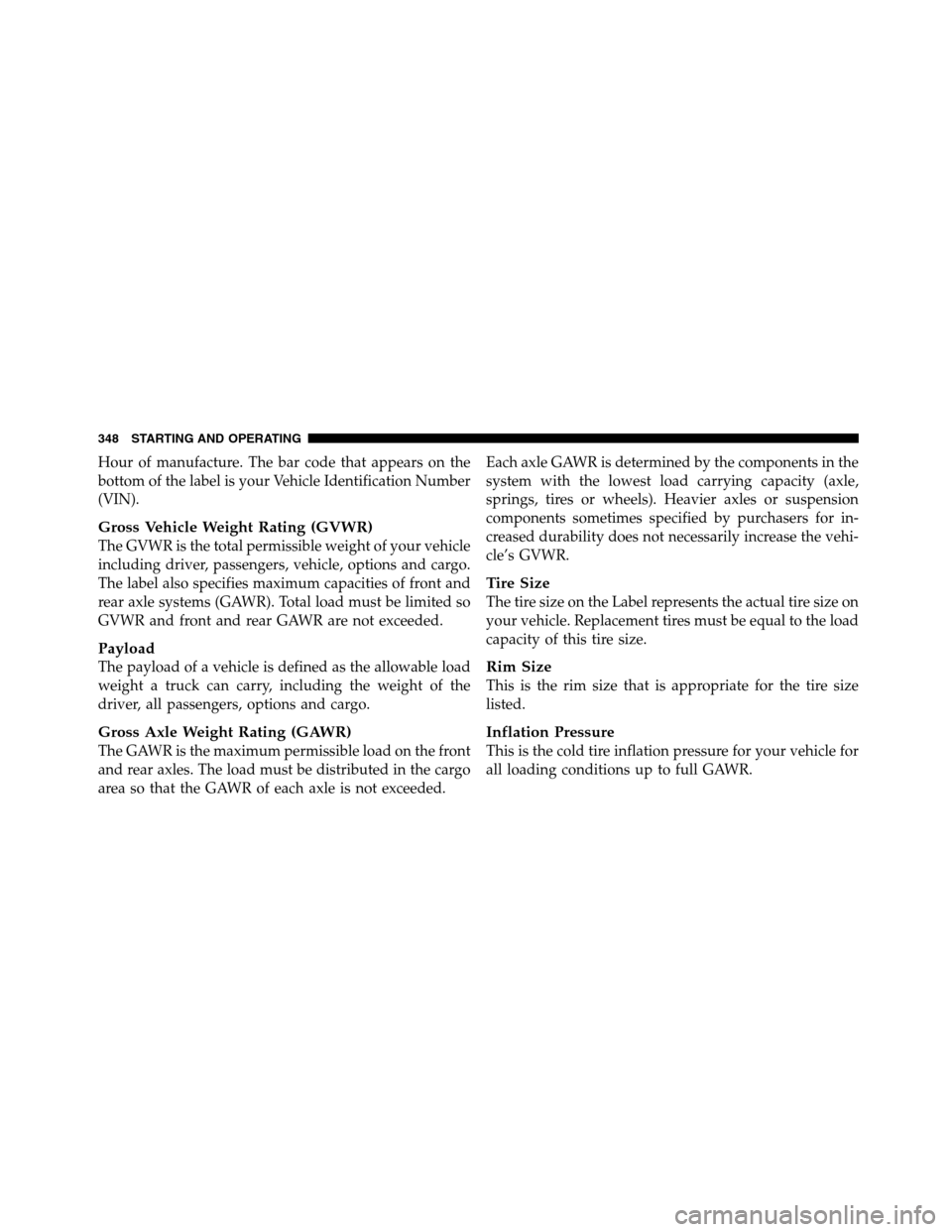
Hour of manufacture. The bar code that appears on the
bottom of the label is your Vehicle Identification Number
(VIN).
Gross Vehicle Weight Rating (GVWR)
The GVWR is the total permissible weight of your vehicle
including driver, passengers, vehicle, options and cargo.
The label also specifies maximum capacities of front and
rear axle systems (GAWR). Total load must be limited so
GVWR and front and rear GAWR are not exceeded.
Payload
The payload of a vehicle is defined as the allowable load
weight a truck can carry, including the weight of the
driver, all passengers, options and cargo.
Gross Axle Weight Rating (GAWR)
The GAWR is the maximum permissible load on the front
and rear axles. The load must be distributed in the cargo
area so that the GAWR of each axle is not exceeded.Each axle GAWR is determined by the components in the
system with the lowest load carrying capacity (axle,
springs, tires or wheels). Heavier axles or suspension
components sometimes specified by purchasers for in-
creased durability does not necessarily increase the vehi-
cle’s GVWR.
Tire Size
The tire size on the Label represents the actual tire size on
your vehicle. Replacement tires must be equal to the load
capacity of this tire size.
Rim Size
This is the rim size that is appropriate for the tire size
listed.
Inflation Pressure
This is the cold tire inflation pressure for your vehicle for
all loading conditions up to full GAWR.
348 STARTING AND OPERATING
Page 359 of 508
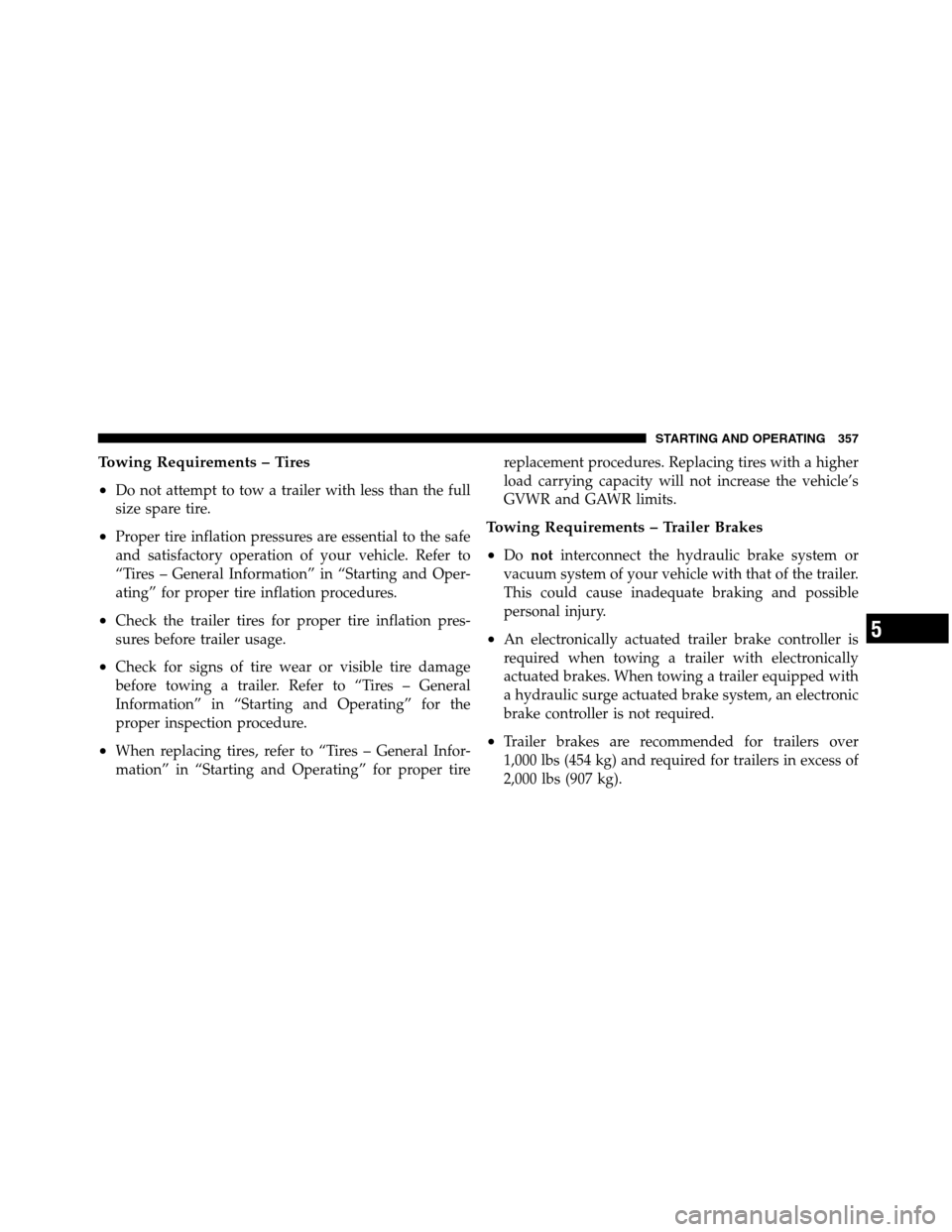
Towing Requirements ‚Äď Tires
‚ÄĘ
Do not attempt to tow a trailer with less than the full
size spare tire.
‚ÄĘProper tire inflation pressures are essential to the safe
and satisfactory operation of your vehicle. Refer to
‚ÄúTires ‚Äď General Information‚ÄĚ in ‚ÄúStarting and Oper-
ating‚ÄĚ for proper tire inflation procedures.
‚ÄĘCheck the trailer tires for proper tire inflation pres-
sures before trailer usage.
‚ÄĘCheck for signs of tire wear or visible tire damage
before towing a trailer. Refer to ‚ÄúTires ‚Äď General
Information‚ÄĚ in ‚ÄúStarting and Operating‚ÄĚ for the
proper inspection procedure.
‚ÄĘWhen replacing tires, refer to ‚ÄúTires ‚Äď General Infor-
mation‚ÄĚ in ‚ÄúStarting and Operating‚ÄĚ for proper tirereplacement procedures. Replacing tires with a higher
load carrying capacity will not increase the vehicle’s
GVWR and GAWR limits.
Towing Requirements ‚Äď Trailer Brakes
‚ÄĘ
Donotinterconnect the hydraulic brake system or
vacuum system of your vehicle with that of the trailer.
This could cause inadequate braking and possible
personal injury.
‚ÄĘAn electronically actuated trailer brake controller is
required when towing a trailer with electronically
actuated brakes. When towing a trailer equipped with
a hydraulic surge actuated brake system, an electronic
brake controller is not required.
‚ÄĘTrailer brakes are recommended for trailers over
1,000 lbs (454 kg) and required for trailers in excess of
2,000 lbs (907 kg).
5
STARTING AND OPERATING 357
Page 502 of 508
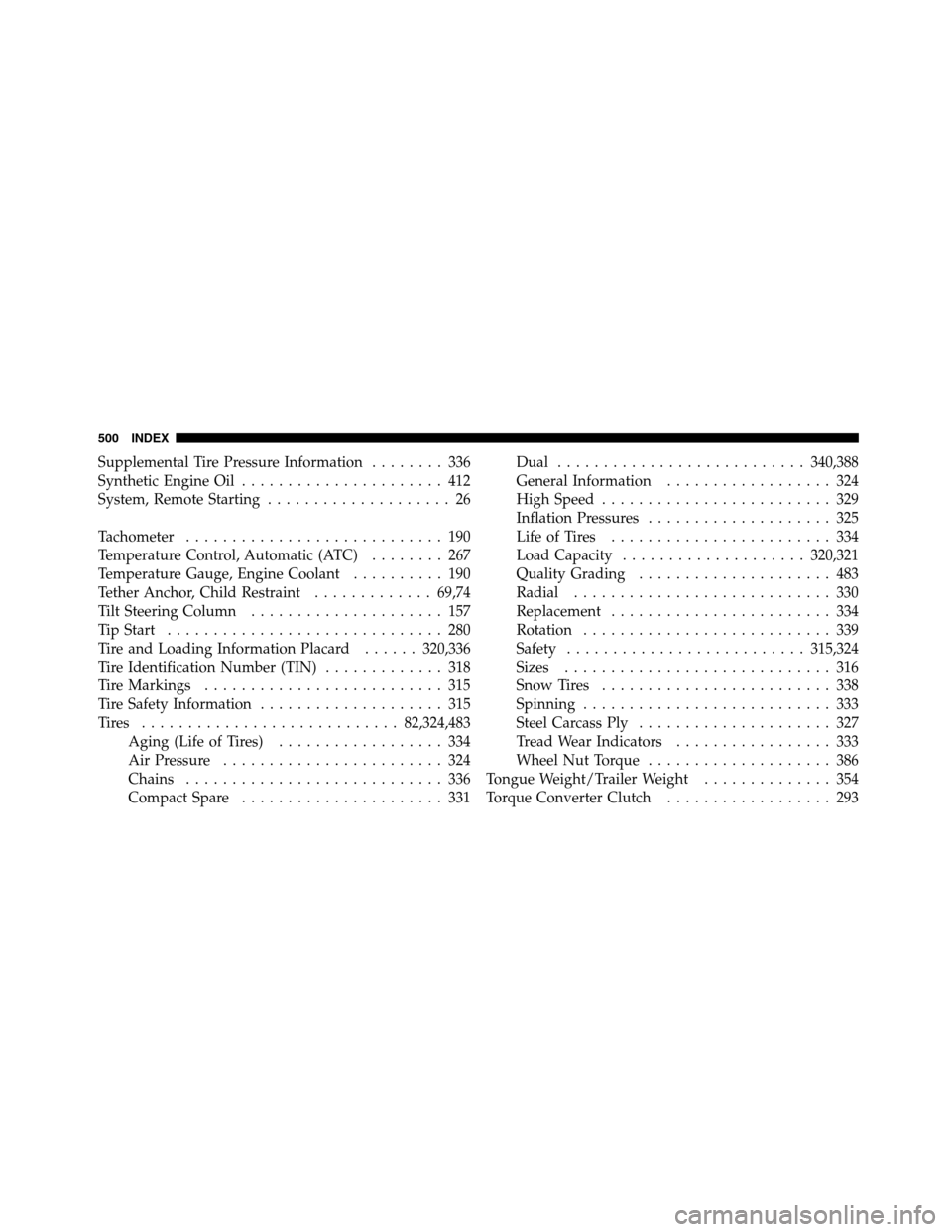
Supplemental Tire Pressure Information........ 336
Synthetic Engine Oil...................... 412
System, Remote Starting.................... 26
Tachometer............................ 190
Temperature Control, Automatic (ATC)........ 267
Temperature Gauge, Engine Coolant.......... 190
Tether Anchor, Child Restraint............. 69,74
Tilt Steering Column..................... 157
Tip Start.............................. 280
Tire and Loading Information Placard......320,336
Tire Identification Number (TIN)............. 318
Tire Markings.......................... 315
Tire Safety Information.................... 315
Tires ............................ 82,324,483
Aging(LifeofTires) .................. 334
Air Pressure........................ 324
Chains............................ 336
Compact Spare...................... 331Dual...........................340,388
General Information.................. 324
High Speed......................... 329
Inflation Pressures.................... 325
LifeofTires ........................ 334
Load Capacity....................320,321
Quality Grading..................... 483
Radial............................ 330
Replacement........................ 334
Rotation........................... 339
Safety..........................315,324
Sizes ............................. 316
Snow Tires......................... 338
Spinning ........................... 333
Steel Carcass Ply..................... 327
Tread Wear Indicators................. 333
Wheel Nut Torque.................... 386
Tongue Weight/Trailer Weight.............. 354
Torque Converter Clutch.................. 293
500 INDEX